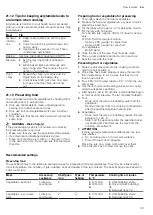
en
Installation instructions
48
2.
Apply suitable foam around the gas connection.
a
If dispersions and bubbles occur on the foamy sur-
face and these indicate that gas is escaping, follow
the instructions in the section entitled "What to do if
there is a gas leak" →
3.
Follow the same instructions for the part that is
sealed with the blind plug.
Checking the cooker burner nozzles
Check the leak tightness of each nozzle.
1.
Open the gas connection shut-off.
2.
To check, carefully cover the hole in the burner
nozzle with your finger or a special device.
3.
Apply suitable foam around the nozzle.
4.
Press on the burner knob and turn the knob anti-
clockwise. Gas therefore comes to the nozzle.
a
If dispersions and bubbles occur on the foamy sur-
face and these indicate that gas is escaping, follow
the instructions in the section entitled "What to do if
there is a gas leak" →
Checking the bypass nozzles
Check the leak tightness of each bypass nozzle.
1.
Open the gas connection shut-off.
2.
To check, carefully cover the hole in the burner
nozzle with your finger or a special device.
3.
Apply suitable foam around the bypass nozzle on
the burner that is to be checked.
4.
Press on the tap spindle and turn it anti-clockwise.
Gas therefore comes to the nozzle.
a
If dispersions and bubbles occur on the foamy sur-
face and these indicate that gas is escaping, follow
the instructions in the section entitled "What to do if
there is a gas leak" →
22.7 Checking the correct burner behaviour
Check the burning and soot formation of each burner
after the product has been converted to a different gas
type. If there is a problem, compare the nozzle values
with the values in the table.
Checking the correct burner behaviour of the
cover burner
1.
Ignite the gas cooker burners in accordance with
the instructions in the operating manual.
→
"Operating the hotplate", Page 17
2.
Set the gas cooker knob to the small flame setting.
Check whether the flame safety system is working
by keeping the flame at the "small flame" setting for
one minute.
3.
Check that the burners are burning correctly with
both large and small flames.
a
The flame must burn evenly and steadily.
4.
Turn the burner knob back and forth quickly
between the large flame setting and the small flame
setting. Repeat this process several times.
a
The gas flame must not flicker or go out.
22.8 Technical data – Gas
The different types of gas and the corresponding val-
ues are listed.
Information on some types of gas
Note the following information for the gas types that are
listed in the table for some burners.
Type of gas
Explanation
G20/25
(20/25 mbar)
For France and Belgium
G2.350
(13 mbar)
For Poland
G30 (50 mbar)
The after-sales service must order
the nozzle set HEZ353110.
Nozzle values for the auxiliary burner
Note the following information for the gas types that are listed in the table for some burners.
G20/
G25
G20
G20
G25
G25
G25.3
G30/
G31
G30
G30
G27
G2.350
Gas pressure (mbar)
20/25
20
25
20
25
25
28–
30/37
50
37
20
13
Nozzle (mm)
0.72
0.72
0.68
0.77
0.72
0.72
0.50
0.43
0.47
0.77
1.00
Bypass nozzle
1
(mm)
0.52/0.
5
0.52/
0.5
0.52/
0.5
0.52/
0.5
0.52/
05
0.52/
0.5
0.32/
0.3
0.32/
0.3
0.32/
0.3
0.52/
0.5
0.52/
0.5
Max. input power (kW)
1
1
1
1
1
1
1
1
1
1
1
Min. input power (kW)
≤0.55
≤0.55
≤0.55
≤0.55
≤0.55
≤0.55
≤0.55
≤0.55
≤0.55
≤0.55
≤0.55
Gas flow at 15 °C and
1013 mbar m
3
/h
0.095/
0.111
0.095
0.095
0.111
0.111
0.108
-
-
-
0.116
0.132
Gas flow at 15 °C and
1013 mbar g/h
-
-
-
-
-
-
73/71 73
73
-
-
1
Use the bypass nozzle with the appropriate diameter that is included in the set.
Nozzle values for the standard-output burner
Note the following information for the gas types that are listed in the table for some burners.





































